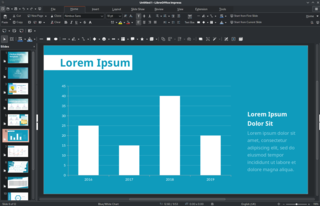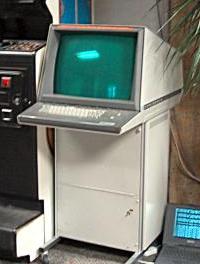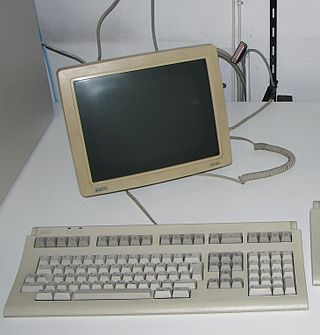Related Research Articles

The Commodore 64, also known as the C64, is an 8-bit home computer introduced in January 1982 by Commodore International. It has been listed in the Guinness World Records as the highest-selling single computer model of all time, with independent estimates placing the number sold between 12.5 and 17 million units. Volume production started in early 1982, marketing in August for US$595. Preceded by the VIC-20 and Commodore PET, the C64 took its name from its 64 kilobytes(65,536 bytes) of RAM. With support for multicolor sprites and a custom chip for waveform generation, the C64 could create superior visuals and audio compared to systems without such custom hardware.

The VIC-20 is an 8-bit home computer that was sold by Commodore Business Machines. The VIC-20 was announced in 1980, roughly three years after Commodore's first personal computer, the PET. The VIC-20 was the first computer of any description to sell one million units. It was described as "one of the first anti-spectatorial, non-esoteric computers by design...no longer relegated to hobbyist/enthusiasts or those with money, the computer Commodore developed was the computer of the future."

In computing, a presentation program is a software package used to display information in the form of a slide show. It has three major functions:

R is a programming language for statistical computing and graphics supported by the R Core Team and the R Foundation for Statistical Computing. Created by statisticians Ross Ihaka and Robert Gentleman, R is used among data miners, bioinformaticians and statisticians for data analysis and developing statistical software. The core R language is augmented by a large number of extension packages containing reusable code and documentation.
IDL, short for Interactive Data Language, is a programming language used for data analysis. It is popular in particular areas of science, such as astronomy, atmospheric physics and medical imaging. IDL shares a common syntax with PV-Wave and originated from the same codebase, though the languages have subsequently diverged in detail. There are also free or costless implementations, such as GNU Data Language (GDL) and Fawlty Language (FL).

Visualization or visualisation is any technique for creating images, diagrams, or animations to communicate a message. Visualization through visual imagery has been an effective way to communicate both abstract and concrete ideas since the dawn of humanity. from history include cave paintings, Egyptian hieroglyphs, Greek geometry, and Leonardo da Vinci's revolutionary methods of technical drawing for engineering and scientific purposes.

Computervision, Inc. (CV) was an early pioneer in Computer Aided Design and Manufacturing (CAD/CAM). Computervision was founded in 1969 by Marty Allen and Philippe Villers, and headquartered in Bedford, Massachusetts, United States. Its early products were built on a Data General Nova platform. Starting around 1975, Computervision built its own "CGP" Nova-compatible 16-bit computers with added instructions optimized for graphics applications and using its own operating system known as Computervision Graphic Operating System (CGOS). In the 1980s, Computervision rewrote their code to operate on Unix-based platforms.

The Tektronix 4010 series was a family of text-and-graphics computer terminals based on storage-tube technology created by Tektronix. Several members of the family were introduced during the 1970s, the best known being the 11-inch 4010 and 19-inch 4014, along with the less popular 25-inch 4016. They were widely used in the computer-aided design market in the 1970s and early 1980s.
JMP is a suite of computer programs for statistical analysis developed by JMP, a subsidiary of SAS Institute. It was launched in 1989 to take advantage of the graphical user interface introduced by the Macintosh operating systems. It has since been significantly rewritten and made available also for the Windows operating system. JMP is used in applications such as Six Sigma, quality control, and engineering, design of experiments, as well as for research in science, engineering, and social sciences.

IGOR Pro is a scientific data analysis software, numerical computing environment and programming language that runs on Windows or Mac operating systems. It is developed by WaveMetrics Inc., and was originally aimed at time series analysis, but has since then evolved and covers other applications such as curve fitting and image processing. It comes with a fully functional programming language and compiler, but many functions are also accessible through menus. IGOR Pro is primarily known for its graphics capabilities, and like Origin and other similar programs, is often used to generate plots for scientific and other publications. Other features include the possibility of extending the built-in functions with external operations (XOP) allowing data acquisition, manipulation and analysis features, communication with external devices and in principle any other task that can be programmed in C or C++.

A heat map is a 2-dimensional data visualization technique that represents the magnitude of individual values within a dataset as a color. The variation in color may be by hue or intensity.
Delbert W. Yocam is a former US chairman and CEO of Borland, former president, COO and director of Tektronix and a former Apple Computer executive. At Apple, during the 1980s, Yocam ran the Apple II group and later became Apple's first chief operating officer (COO). He served on the board of directors at Adobe Systems.

The Tektronix 4050 is a series of three computer graphics microcomputers produced by Tektronix in the late 1970s through the early 1980s. The display technology is similar to the Tektronix 4010 terminal, using a storage tube display to avoid the need for video RAM. They are all-in-one designs with the display, keyboard, CPU and DC300 tape drive in a single desktop case. They also include a GPIB parallel bus interface for controlling lab and test equipment as well as connecting to external peripherals. A simple operating system and BASIC interpreter are included in ROM.

A BBC Micro expansion unit, for the BBC Micro is one of a number of peripherals in a box with the same profile and styling as the main computer.

UTEXAS is a slope stability analysis program written by Stephen G. Wright of the University of Texas at Austin. The program is used in the field of civil engineering to analyze levees, earth dams, natural slopes, and anywhere there is concern for mass wasting. UTEXAS finds the factor of safety for the slope and the critical failure surface. Recently the software was used to help determine the reasons behind the failure of I-walls during Hurricane Katrina.
Psychometric software is software that is used for psychometric analysis of data from tests, questionnaires, or inventories reflecting latent psychoeducational variables. While some psychometric analyses can be performed with standard statistical software like SPSS, most analyses require specialized tools.

Batteries Included was a computer software and hardware company based in the Toronto area. It developed products for the Apple II, Atari 8-bit family, Atari ST, Commodore 64, and MS-DOS. The company was best known in the 1980s for its popular PaperClip word processor, which was available for the Atari 8-bit family and Commodore 64. Batteries Included was acquired by Electronic Arts in 1987.

The VT320 is an ANSI standard computer terminal introduced by Digital Equipment Corporation (DEC) in 1987. The VT320 is the text-only version, while the VT330 adds monochrome ReGIS, Sixel and Tektronix 4010 graphics, and the VT340 adds color.
References
- 1 2 James C. Condon (March 27, 1983). "Charts on computer graphics are trending upwards". The New York Times .
- ↑ "Guide to using Cuechart, Tellagraf, and Disspla at ANL".
Guide to Curchart, Tellagraf, and Disspla at ANL provides information necessary for using the three ISSCO graphics packages at Argonne
- ↑ Judith Bird (1986). "Mainframe graphics for business presentations". Data Processing. 28: 26–27. doi:10.1016/0011-684X(86)90188-7.
... software such as Issco's Tellagraf at. &6500, input device like a VT100 screen or Tektronix 4702 costing. E2 000-4000 and an output device, such as an HP
- 1 2 D Michalopoulos (1982). "nbin proucs - IEEE Xplore". doi:10.1109/MC.1982.1654116.
{{cite journal}}: Cite journal requires|journal=(help) - ↑ Cuechart with Tell-a-Graf is machine- and device-independent, permitting it to operate with most major computers and ...
- ↑ "Tellagraf graphics software". Computerworld. September 27, 1982. p. 28.
- ↑ CA-TELLAGRAF User's Guide. 1987.
Title, CA-TELLAGRAF User's Guide, Volume 2. CA-TELLAGRAF User's Guide, Computer Associates International.
- ↑ "CA Tellagraf Overview".
- ↑ Dorothy Hu Huang. "Utilizing SAS Software to generate ... CA-Tellagraf as an example" (PDF).
Utilizing SAS Software to generate command language programs, using CA-Tellagraf as an example
- ↑ Some even wrote their own quick-start guide: Computing Center Memo. University of Michigan Computing Center. 1983.
The reason for this is that the color set for the background is generated by the camera, and then the picture generated by *TELLAGRAF is drawn on top.
- ↑ David L. Huston; David MacArthur Miller; Denise A. Wiltshire (1983). "Arizona's Industrial Rock and Mineral Resources: Workshop Proceedings".
The box plots were prepared by using CA–TELLAGRAF to generate the linework and text.
- ↑ TELLaGRAF & CueChart (LBKL). October 1983.
- ↑ "Merging Graphics". February 25, 1998.
The plots can be created with any of the available graphics packages on VM/CMS-- DISSPLA, TELLAGRAF, etc.
- ↑ Jukka Kiijarvi. "Lunowa - Programming - Data Plotting Software".
- ↑ "capture retro*graphics on your dectm terminal. - IEEE Xplore".
... ISSCO. DISSPLA and TELLAGRAF are registered trademarks of Integrated Software Systems Corp
- ↑ a proprietary conversational graphics program from ISSCO of San Diego, CA.
- ↑ TELL-A-GRAF in MTS, Dave Whipple, Computing Center Memo 450, University of Michigan, March 1983.
- ↑ Greg Johnson (August 13, 1985). "Software Firm Seeking". The LA Times.
buying a company that would give ISSCO ... for the personal computer market.
- ↑ "Issco agrees to buy maker of Time Line". InfoWorld. October 13, 1986. p. 31.
- ↑ "Breakthrough to Withdraw from Merge Plans with ISSCO". InfoWorld. December 15, 1986. p. 16.
- ↑ following what was reported as "frosty reception by users." "Issco Sigh of relief". ComputerWorld. March 2, 1987. p. 8.
- ↑ "Dave Lavery - Program Executive for Solar System Exploration (NASA)". February 1987.
Proceedings of the 12th Annual ISSCO Users Group Meeting, Los Angeles California,. February 1987
- ↑ "About Peter and Peggy Preuss".
- ↑ Calvin Sims (June 2, 1987). "Software giants plan merger". The New York Times .
- ↑ "Tellaplan system". ComputerWorld. July 4, 1983. p. 29.
- ↑ Enterprise, I. D. G. (1986-10-27). "New products: Issco".